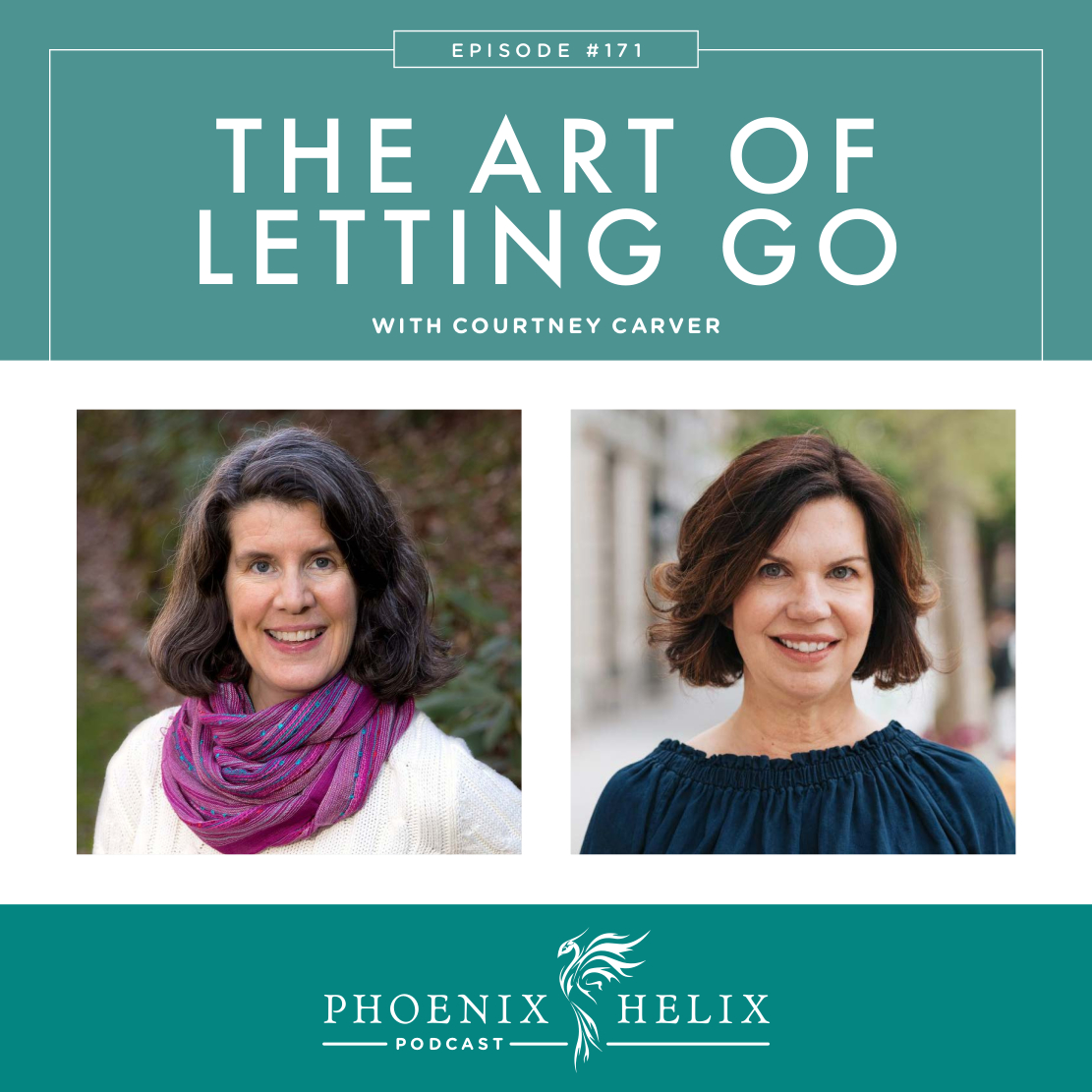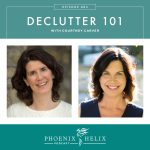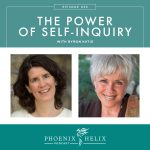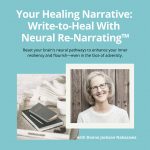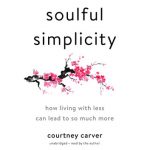Releasing Burdens
Releasing a burden we’ve been carrying too long can lighten both body and soul. Yet this can be one of the hardest things to do, even when we want to do it. Why is letting go so hard? Are there things we can do to make it easier? In this episode, we talk about fostering a letting go mindset, goals for letting go, techniques for doing that successfully, and knowing when NOT to let go. My guest is Courtney Carver, the woman behind the website Be More with Less and the author of the book Soulful Simplicity. She’s one of the leading voices in the minimalist community, but today we’re not talking about letting go of material things. Courtney has a lot of wisdom to share about letting go in general.
Listen to the Show
- Subscribe to my podcast through your favorite podcast app: iTunes, Stitcher, Google, TuneIn, Spotify, Amazon, etc.
- You can also listen to the episode right here through the player below, and if you subscribe to my newsletter you’ll get notified of future episodes.
Podcast: Play in new window | Download
Show Notes
- Intro (0:00)
- Thank You to Our Podcast Sponsor – Your Healing Narrative – an Online Course by Donna Jackson Nakazawa (2:10)
- There’s a close connection between trauma and autoimmune disease. Trauma can wire our brains into a default inflammatory response. For that reason, people with a history of trauma are more likely to be diagnosed with autoimmune disease and experience more severe symptoms.
- But that’s not where the story ends. There are things we can do to rewire our brains for health and build resilience back into our lives. That’s what this online course is all about. Donna calls this Neural Re-Narrating™.
- If you aren’t familiar with Donna’s work, she’s one of my most popular podcast guests. She is an award-winning science journalist and the author of six books. Her expertise is the science of the mind-body connection and how to harness it for health. She also has autoimmune disease herself, so she understands this experience from the inside out.
- This class includes 8 lessons with over 100 activities. It includes video, audio, and written resources and exercises. It’s also self-paced so you can start today!
- Learn more through her website: DonnaJacksonNakazawa.com, and save $30 with the code PHOENIX30. Purchase here.
- Meet Courtney (4:02)
- Courtney Carver is the author of the blog, Be More with Less, as well as two books: Soulful Simplicity and Project 333.
- When she was diagnosed with multiple sclerosis in 2006, she made a goal of reducing stress throughout her life, as a way to optimize her health. Simplicity was the common thread. She learned to focus on what mattered most, and to let go of those things that didn’t support her health and happiness.
- Listen to my prior interview with Courtney – Ep. 84: Declutter 101.
- Things We’d Like to Let Go (6:14)
- We decided to start the conversation brainstorming some things that may be beneficial to let go. We could have listed a hundred things. We each chose our top five.
- Eileen: (1) Things outside of my control, (2) The past, (3) Self-limiting beliefs, (4) Unhealthy relationships, and (5) Intense self-criticism.
- Courtney: She strives to remove the things that remove her from her life, and prevent her from being present. Over the years, that’s included (1) Debt, (2) Clutter, (3) Alcohol, (4) Caring what other people think of her (or having the delusion that they think of her much at all), and (5) Being attached to outcomes.
- Fostering a Letting Go Mindset (8:52)
- Courtney believes that holding on is much harder than letting go. Thinking about it every day, worrying about it – that’s incredibly hard. Letting go is actually easier, and it makes room in your life for what’s meant to come next.
- One mindset shift that has helped her is to “change the way she changes”. In the past, she would try to change everything all at once – fast and furious, looking for immediate and big results. Go big or go home! Eventually she always ended up back home (where she started) feeling totally burnt out. Now, she pursues change slowly and steadily. She knows that tiny steps add up to big changes over time, and she celebrates her progress along the way. She doesn’t wait until crossing a finish line far into the future to feel good about the changes she’s making.
- When it comes to letting go of what people think of you, realize that most of the time, it’s not about you. It’s a reflection of them and what they are struggling with in their own lives. This is also true for us when we judge other people. Not always, but often. This awareness helps Courtney under-react instead of over-react. She also doesn’t attend every argument she’s invited to. Not responding at all can be a freeing option – especially online.
- Letting go of things outside of our control – The Serenity Prayer can be helpful: God grant me the serenity to accept the things I cannot change, the courage to change the things I can, and the wisdom to know the difference. A non-religious framerwork is the Sphere of Concern vs. Influence. Fear lives in the sphere of concern. Personal action takes place in the sphere of influence. Another framework that has helped both Courtney and Eileen is Byron Katie’s Teachings. She speaks of three types of business: My Business, Your Business, and God’s Business. If we’re in everybody’s business but our own, not only are we ineffective, but no one’s minding our business. There’s a lot we can accomplish within our business (the things we can control) when we aren’t distracted elsewhere.
- Emotions aren’t emergencies – This is one of Courtney’s favorite phrases. It reminds her to pause and take a breath instead of just reacting when she’s upset about something. Instead, she asks herself, “Does this require action, or am I simply reacting? Can it wait until tomorrow when I’m feeling calmer?” Then, she can mindfully choose how she wants to engage, if at all. Controlling this – how we react and engage with others and the world – can eliminate a lot of stress and drama from our lives.
- The Art of Letting Go isn’t The Art of Not Caring. It’s not about becoming numb or completely self-centered. Instead, it’s clarifying the space you take in your life, your body, your relationships, and the world. It’s being discerning with where your energy, intentions, and actions go.
- What Is Doomscrolling? (23:10)
- This refers to time online where you are bombarded with bad news that leaves you feeling dazed and overwhelmed, and can increase depression, anxiety, and a sense of hopelessness. Spending too much on social media or news sites can cause this effect.
- Courtney & Eileen both take intentional time offline on a regular basis. Eileen takes at least one day completely offline, and also limits her daily time on social media and news sites. Courtney has a personal boundary where she doesn’t watch news. Instead, she reads it through a daily newsletter called The Skimm.
- Courtney also notices that she’s more likely to doomscroll when she’s tired, hungry, thirsty, or overwhelmed. Then she turns to social media to self-soothe (even though it’s not very soothing.) When she’s taking care of her mind and body, the impulse isn’t as strong. So, if she has the impulse to doomscroll, it’s a signal to ask herself what she truly needs.
- Resources:
- Self-Limiting Beliefs (26:06)
- This is the opposite of trying to change things we can’t control. This is where we underestimate what’s actually within our control, and limit our goals and actions accordingly.
- We can’t control other people, we can only control ourselves. But what happens when we limit ourselves too much? It’s usually tied to an inner critical voice that tells us we’re not capable, or we’re not worthy. Investigating where this voice comes from can help to let it go. Often it’s a story from our past that no longer applies to our present. It can also be the voice of fear, trying to protect us in a way that isn’t helpful.
- Resources:
- Journaling as a Tool for Letting Go (28:52)
- Both Courtney and Eileen have a personal journaling practice, and it can be very helpful in the process of letting go. There’s something about putting pen to paper that’s different than just talking about something. The journal holds it for you, which can make it easier to let go.
- For Courtney, journaling also interrupts cycles of rumination. She puts obsessive thoughts on paper and then questions them: Is this true? Is this real? Is this important?
- Journaling can also be a powerful form of inner exploration – looking within yourself for answers. We often know more than we realize.
- Courtney adds an extra level of letting go to her journaling practice. Because her journals are for her alone, and she doesn’t want them to ever be read by others, she doesn’t keep her journals. Once they’re complete, she burns or shreds them. Not everyone would want to do this, but it’s an intriguing idea.
- If you’re not a writer, visual journals are wonderful too, and they don’t require artistic talent. Visual art taps a different part of our brains than the written word and can lead to answers you wouldn’t find any other way.
- Resource:
- Thank You to Our Podcast Sponsor – ShopAIP (36:59)
- Today, I’m highlighting Sip Herbals. Are you missing coffee on the AIP? Not anymore! This herbal tea contains just 3 organic ingredients: roasted chicory, roasted carob, and dandelion root. The result is a flavor that’s dark, rich, toasty, earthy, and nutty. In addition to being caffeine-free, it contains herbs with benefits for both gut and liver health.
- ShopAIP is an online store dedicated to the Paleo Autoimmune Protocol. With hundreds of items for the elimination phase of the AIP, and new products labeled by reintroduction category as well. You can find protein bars, sauces and condiments, AIP-friendly spices, cooking and baking ingredients, delicious snacks, non-toxic skincare, and more.
- If you’re a first-time customer, use the code PHOENIX for 10% off your order. Purchase here.
- Other Mind-Body Techniques for Letting Go (38:05)
- The mind-body connection works both ways. Moving your body can simultaneously “move” your mind into a more positive place.
- Sleep can have a big impact on mindset and the ability to let go.
- Both Courtney and Eileen meditate daily. In fact, Courtney meditates twice a day.
- Courtney also loves placing her hands on her heart as both a calming practice and a listening practice. She listens to her heartbeat, connects to her body and checks in – how are you feeling? I’m here for you.
- The Art of Letting Go is the Art of Tuning In (43:50)
- It’s about getting to know yourself better – both your needs and your triggers. It’s about asking yourself questions and tapping your own inner wisdom. Is this within my control? Is this my business or someone else’s business? Why is this triggering me so deeply? Do my actions match my words? Why am I doing what I’m doing? (Whether it’s eating a certain way, acting a certain way, or struggling with a specific issue.)
- Food and Letting Go (41:47 & 44:26)
- Nutrition affects mindset as well. Courtney said earlier that if she’s hungry, she struggles more with letting go. For Eileen, eating too much sugar (even natural ones) negatively impacts her mind and body.
- But there’s a flipside to this, too. For Courtney, sometimes the stress of denying herself a treat and obsessing over it can negatively impact mindset more than the food itself. She started weighing herself when she was 9 years old and didn’t stop until 2 years ago. While she told herself she wasn’t dieting for weight loss, her actions said otherwise. Letting go of the scale has been transformative.
- For Eileen, shifting her mindset from “I can’t eat that” to “I choose not to eat that” has been powerful. Also, part of a long-term healing diet is finding your wiggle room. Eileen knows which foods support her health and which ones cause inflammation. But even in this latter group, there’s a range of responses. Some foods she always avoids because the pain is severe, but some foods she indulges in once in a while because the response is mild. It’s another level of knowing herself and listening to her internal wisdom over an external set of diet rules.
- Resources:
- Therapy as a Tool for Letting Go (48:09)
- Both Courtney and Eileen have found therapy very helpful at certain times in their lives. If you’re struggling to let go on your own, consider the help of a professional.
- Thanks to the mind body connection, our bodies can benefit from therapy as well. (Research: Psychological therapy helps reduce chronic inflammation.)
- Letting Go and Autoimmune Disease (49:20)
- With chronic illness, life changes a lot. We often struggle to let go of our past sense of self and what our life looked like before our diagnosis. It’s common to have anger toward our body, anger toward ourselves, or the world.
- After her diagnosis, Courtney made a lot of lifestyle changes to support her health, and she wondered if she was to blame for her diagnosis since she didn’t make those changes before. She realized the answer is no, and came up with this mantra: “I’m not responsible for my MS, but I am responsible to it.” She does what she can to maximize her health but releases the blame, shame, and guilt that aren’t helpful. In fact, those emotions can worsen symptoms by increasing inflammation in the body.
- She also recommends staying in the present, with no comparison to the past. Our bodies are always going to change from day to day, and year to year. All we can do is be here in this moment, and make the best of what we have. This is also an area where we can look at self-limiting beliefs as well as the things inside and outside of our control.
- A journal exercise for letting go: Write a letter to your body. Be honest about the grief and anger. But also try to find compassion and gratitude for all your body has survived, and how hard it tries to keep you healthy, and everything it’s doing right. Lastly, imagine your body as a child. How would you feel differently? Would you blame your body quite as much, or would you have a deep compassion for all that it’s gone through?
- Resources:
- How to Engage With Issues We Care About (21:35 & 55:03)
- If we care deeply about everything, we become overwhelmed and our actions get diluted across many different causes. That’s ineffective and leads to burnout. It’s helpful to choose the things you care about the most and direct your action there for a greater impact. Trust that the world is full of caring people who will make their impact in different ways.
- Also, gain comfort with what you are able to give, and with autoimmune disease that will change based on your health. There will be times that you have a great capacity to give, and other times when you’re in survival mode and need to focus on yourself. We all need to balance self-care with community care.
- Dani Coke is a Black artist and activist who strives to help people turn purpose into action. This graphic is very helpful. She also has a newsletter, and if you sign up, you receive a free PDF that helps you create a personalized action plan.
- Resources:
- Article: 5 Tips for Cutting Through Overwhelm in the Face of World Tragedies.
- Podcast: Navigating the News with Sharon McMahon.
- 5 Things to Never Let Go (58:03)
- Humor
- Intention
- Rest
- Grace
- Joy
- Courtney’s article: Never Let Go of These 5 Things.
- Outro (1:01:03)
- Courtney Carver is is the author of the blog, Be More with Less, as well as two books: Soulful Simplicity and Project 333. She also has a podcast: Soul and Wit.
- Eileen (your podcast host) is the author of multiple books, written to help people thrive with autoimmune disease. Learn more on the Books Page.
- If you like this podcast, follow or subscribe through your favorite podcast app. You can also subscribe to Eileen’s biweekly newsletter.
- Check out the entire archive of podcast episodes.
You May Also Be Interested In
Spreading the Word
If you like the podcast, please leave a positive review in iTunes. It would mean the world to me, and also helps others find the podcast. Here are some quick instructions using your iPhone:
- If you are already subscribed to my podcast: (1) Click the purple podcast icon. (2) At the bottom of the screen, click Library. (3) At the top of the screen, click Shows. (4) Click the Phoenix Helix podcast image. (5) Scroll down the page, and you’ll see Ratings and Reviews. Scroll down a little bit more and click on Write a Review. This will bring up the review screen. Tap 5 stars (if you love the podcast), and then click in the title box, and it will bring up the keyboard. Enter a title and short review. (6) Click Send in the upper right corner. (7) Thank you! Positive reviews give the podcast a higher search ranking in iTunes, helping people find it and letting them know it’s a quality podcast and worth their time to listen.
- If you haven’t subscribed to my podcast: (1) Click the purple podcast icon. (2) In the lower right corner, click the magnifying class. (3) Type Phoenix Helix in the search box. (4) Click the podcast cover in the Show list. (5) If you’d like to subscribe, click the + sign at the top of the screen. (6) To write a review, scroll down the page, and you’ll see Ratings and Reviews. Scroll down a little bit more and click on Write a Review. This will bring up the review screen. Tap 5 stars (if you love the podcast), and then click in the title box, and it will bring up the keyboard. Enter a title and short review. (7) Click Send in the upper right corner. (8) Thank you! Positive reviews give the podcast a higher search ranking in iTunes, helping people find it and letting them know it’s a quality podcast and worth their time to listen.

